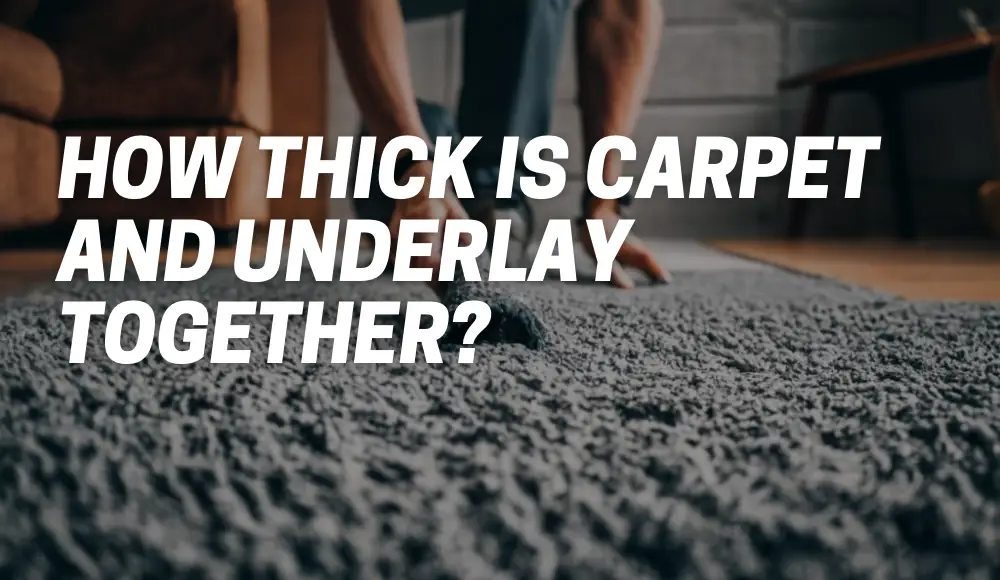Last updated on October 28th, 2023 at 01:08 pm
When it comes to choosing the right carpet and underlay for your home, one of the most critical factors to consider is their thickness. The combined thickness of these two elements can greatly influence the comfort, insulation, durability, and overall ambiance of your living space. In this in-depth guide, we will explore the world of carpet and underlay thickness, answering all your burning questions and helping you make an informed decision about your flooring.
What is the Thickness of the Carpet and Underlay Together?
The thickness of the carpet and underlay together varies, but it’s typically measured in millimeters. The combined thickness can range from as thin as 5mm to as thick as 20mm (0.2-0.78 inches) or more, depending on your preferences and specific requirements.
How Does Thickness Impact Comfort and Insulation?
The thickness of both the carpet and underlay can significantly impact the comfort and insulation of your home. A thicker combination offers better underfoot comfort, making it a joy to walk, sit, or even lie down on. Additionally, it provides enhanced insulation, keeping your home warmer in the winter and cooler in the summer.
For instance, imagine coming home after a long day and sinking your feet into a plush, thick carpet with a cushy underlay. It’s like a warm embrace for your feet, especially during the chilly months. Conversely, a thinner combination may not provide the same level of comfort or insulation.
How Thick is Carpet Usually?
Carpet thickness can vary, but a typical range falls between 5mm and 12mm. This range caters to various preferences, from a sleek and low-profile look to a more luxurious, cushioned feel underfoot.
Is There a Specific Carpet Thickness Term?
In the world of carpets, you might come across the term “pile height.” This refers to the thickness of the carpet fibers or the length of the fibers above the backing material. While it’s not exactly the same as the overall thickness, it is an essential factor to consider when evaluating carpet thickness.
How Thick is the Carpet Pad Usually?
Carpet pads, also known as underlays, typically have a thickness ranging from 6mm to 10mm. These underlays provide additional cushioning and support to the carpet.
How Do I Measure the Combined Thickness of Carpet and Underlay?
Measuring the combined thickness of carpet and underlay is a straightforward process. You’ll need a tape measure. Follow these steps:
- Select a representative area: Choose an area where you want to measure the thickness. It’s best to select a spot where you can easily access both the carpet and underlay.
- Push the tape measure: Push the tape measure down through the carpet and into the underlay until it reaches the floor. Take note of the measurement.
- Repeat: Measure in multiple locations to ensure accuracy. The average of these measurements will give you a good idea of the overall thickness.
What Are the Benefits of a Thicker Carpet and Underlay Combination?
Choosing a thicker carpet and underlay combination comes with several advantages:
1. Improved Comfort: Thicker carpet and underlay feel softer underfoot, making your home a cozy and comfortable haven.
2. Enhanced Sound Insulation: Thicker materials absorb sound better, reducing noise transmission between floors, which is ideal for apartments or multi-story homes.
3. Longevity: Thicker carpets and underlays tend to be more durable, with better resistance to wear and tear.
Is There an Industry Standard for Carpet and Underlay Thickness?
While there is no strict industry standard for carpet and underlay thickness, there are general recommendations. In most cases, professionals suggest a total thickness of 9mm to 12mm for a good balance of comfort and durability. However, the best choice may vary depending on the specific needs of your space.
How Does Thickness Affect Carpet Durability?
The thickness of the carpet and underlay has a direct impact on the durability of your flooring. Thicker carpets and underlays often outlast their thinner counterparts. Thicker materials can better withstand heavy foot traffic and the test of time, maintaining their appearance and comfort for longer.
What Are the Different Types of Underlay and Their Thickness Options?
Underlays come in various materials and thickness options, allowing you to tailor your choice to your specific requirements. Common underlay materials include foam, rubber, and felt. Thickness options generally range from 6mm to 10mm, but specialty underlays may offer different thicknesses to suit particular needs.
Table: Types of Underlay and Their Thickness Options
| Underlay Material | Thickness Range (mm) | Characteristics |
|---|---|---|
| Foam | 6 – 8 | Provides cushioning and insulation. Suitable for most residential applications. |
| Rubber | 6 – 10 | Offers exceptional durability and noise reduction. Ideal for high-traffic areas. |
| Felt | 8 – 10 | Provides a luxurious feel and excellent insulation. Great for added comfort. |
Does a Thicker Carpet and Underlay Provide Better Insulation?
Yes, a thicker combination of carpet and underlay provides better insulation. The additional layers trap air and create a thermal barrier, making your home more energy-efficient and comfortable. Thicker flooring also helps reduce drafts and temperature fluctuations.
What Factors Should I Consider When Choosing Thickness?
Several factors should influence your decision on carpet and underlay thickness:
- Room Usage: Consider how the room will be used. A thicker combination may be more suitable for a cozy living room, while a thinner option could work well in a home office.
- Personal Preferences: Think about your own comfort and style. What feels best underfoot, and what complements your decor?
- Budget: Thicker carpets and underlays are generally more expensive. Ensure your choice aligns with your budget.
Can a Thicker Carpet and Underlay Help Reduce Noise?
A thicker carpet and underlay combination is excellent at reducing noise. The additional layers absorb sound and minimize its transmission between floors. This is especially beneficial in multi-story homes, apartments, or areas where noise control is essential.
Are There Downsides to Using a Very Thick Combination?
While thicker carpets and underlays offer many benefits, there are some potential downsides to consider:
- Cost: Thicker materials are usually more expensive than their thinner counterparts.
- Cleaning Challenges: Thicker carpets may be more challenging to clean, and they can trap dirt and dust more easily.
- Installation Challenges: Thicker flooring can be more challenging to install, and it may require professional installation.
What Are the Popular Thickness Options in the Market?
In the market, you’ll find a wide range of thickness options for both carpet and underlay. However, the most popular thickness options for carpet generally fall between 9mm and 12mm, while underlay thickness commonly ranges from 6mm to 10mm.
How Does Thickness Impact the Overall Look and Feel of a Room?
The choice of carpet and underlay thickness can significantly influence the aesthetics and ambiance of a room. Thicker options create a more luxurious and cozy atmosphere, while thinner choices offer a sleek and minimalistic look.
What is the Cost Difference Between Various Thickness Options?
The cost of carpet and underlay varies based on their thickness. Thicker materials are typically more expensive than thinner ones due to the increased material and manufacturing costs. When considering your budget, remember that investing in a thicker carpet and underlay combination often pays off in terms of comfort and longevity.
How Much to Allow for Carpet and Underlay
When calculating the budget for your flooring project, you should allocate a significant portion for the carpet and underlay. Depending on your choice of materials, quality, and thickness, this cost can vary, but it’s an investment that contributes to the overall comfort and style of your home.
How Thick is Carpet and Underlay Together for Stairs
When it comes to carpeting stairs, it’s crucial to balance safety and aesthetics. Typically, a combined thickness of around 12mm is a good choice for staircases. It provides the needed cushioning while ensuring a secure footing.
In conclusion, the thickness of your carpet and underlay is a critical factor in creating a comfortable and cozy home. It affects everything from how your floors feel underfoot to the insulation of your space and even the overall cost of your flooring project. By understanding the various aspects of carpet and underlay thickness, you can make an informed decision that suits your specific needs and preferences.
Now, you’re ready to make the best choice for your home’s comfort, style, and functionality. Choose wisely and enjoy your plush, insulated haven.



